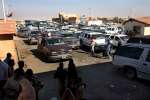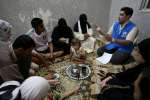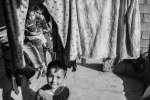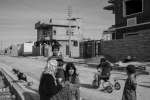- Text size
 |
|  |
|  |
| 
- Français
Solidarity between different generations of Central African refugees in Cameroon
Telling the Human Story, 12 August 2014
GBITI, Cameroon, August 12 (UNHCR) – Motivated by a sense of solidarity, Bouba Mairama has been a mother figure to many of the thousands of refugees who fled Central African Republic earlier this year and crossed the border to the small town of Gbiti. She provided clothes to replace their rags; she gave them food and water, she took in and educated unaccompanied children and she offered helpful advice to women and girls emerging from the bush.
Mairama had made the journey herself, but eight years before in 2006, fleeing from Bozoum in the west of Central African Republic with her family because of growing lawlessness and attacks on her ethnic Peul community. "We fled at night. We did not even have shoes," she recalled, adding that her husband had later died of illness in Cameroon.
The current situation is far worse, with stepped up inter-communal violence since December causing tens of thousands to flee, including some 120,000 to Cameroon. But Mairama knew what the first new arrivals were going through and her response showed the solidarity between older refugees and the new arrivals at the start of the crisis. The transit centre at Gbiti has since closed and refugees have been relocated to camps, but the solidarity remains.
Mairama, who heads the women's refugee committee in Gbiti, recalled that when the first refugees began arriving months ago, they lacked clothing, shoes, money, food. "Hunger was killing them," said the mother of six, adding : "We gave them our own clothes. We organized meetings with all the refugee women, we collected money, we paid for clothes and soap, and we gave them food." She also offered her own home to 18 of the many children who arrived at Gbiti on their own after losing parents or getting separated in flight.
She provides them with food, clothes and an education in the small Muslim school she set up in her courtyard for refugees from the current and earlier influxes. Children stay with Mairama until she can find their family; she has so far reunited all but three of the 18 children she has taken in since December.
Most of the 20,000 refugees that have arrived in the Gbiti area since December rely on help from organizations like UNHCR, which provide emergency assistance and care before their transfer to new refugee sites. But, in the spirit of solidarity, the local community, including the refugees like Mairama from earlier waves of arrival, also play an important humanitarian role by offering shelter and other assistance.
Mairama has always helped people in need, even when she lived in the Central African Republic and the country was swept by periodic waves of violence and forced displacement. When the first Central African refugees started arriving, she could not stand by and do nothing. "Even if I don't have the means, if I see one person who is in misery, I will take him," she explained.
She said the other members of the refugee women's committee felt the same way. "We feel pity," Mairama stressed. "We find money to provide medical treatment for those who need it," she added.
Since the start of the year, the members of the refugee women's committee have collected about 1.5 million Central African Francs, which is the equivalent of US$3,100. It may not sound like a lot, but it goes far out here.
"I make and sell doughnuts and corn flour. I sell bananas, avocados and peanuts. I have two fields and I grow corn, peanuts, potatoes, beans and bananas," Mairama said, explaining how she was able to do her bit to raise money and buy aid items.
But she is also receiving help from UNHCR, which provides her with basic relief items, including sleeping mats and blankets, for the refugee children she looks after. "UNHCR is helping us. When we [first] arrived as well, UNHCR was here," she said, while adding: "We still need their help."
When she saw people staggering across the border, many in dreadful physical and mental shape after an ordeal in Central African Republic often lasting weeks, Mairama despaired of ever returning home.
"The situation is not good," she noted, a tense look on her face. Then she looked at the children, reciting the Koran in her courtyard, and smiled. But Mairama can't help thinking that their future lies in Cameroon because of the discord and new divisions back home.
By Céline Schmitt in Gbiti, Cameroon









































